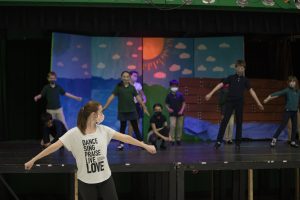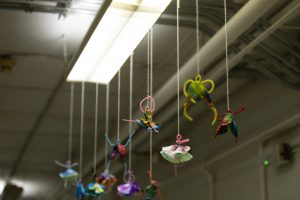Academic Excellence
One of the most difficult decisions a parent can make is where to your send your child to school. Holy Family Catholic School welcomes you. We accept children from pre-school through 8th grade.
Programs
Fine Arts
At Holy Family School, the fine arts are an integral part of our curriculum. Our students have an opportunity to express their spirit and creativity through the disciplines of vocal music, dance, band, drama, and the visual arts.
Engagement with the fine arts enhances a student’s intellectual, social, and personal development. Research evidence indicates that the fine arts develop neural systems in the brain that engender a wide spectrum of benefits such as improved fine motor skills and emotional balance. Fine arts education produces higher test scores and greater self-discipline. The arts provide students with new ways to access meaning, to perceive the word around them, to comprehend and problem solve. They give students the tools they need to transcend the boundaries of language, culture, time, and space. The fine arts promote self-esteem, motivation, inventiveness, aesthetic awareness, and appreciation of beauty and diversity, attributes which enable our students to become productive and active members of their communities.
Art class is offered for students Kindergarten through 8th grade.
The dance program kicked off in the early 1990s. Students experience the joy of dance through ballet, tap, jazz and tumbling. The student body even presents a recital each spring.
STEM Education
Holy Family School is a leader in the field of STEM education. STEM (Science, Technology, Engineering, and Mathematics) Education is an approach to teaching that integrates real-life applications of technology, math, engineering and science with experiential, hands-on learning. STEM education provides students with the 21st century learning skills they need to address complex real-world problems.
Let’s consider how STEM affects what is closest and dearest to us – our children. STEM is the future – it provides students with learning experiences that prepare them to be leaders in a global and technologically advanced society. According to the United States Department of Labor, eight of the ten leading career opportunities require proficiency in the STEM fields – accounting, computer science, electrical engineering, mechanical engineering, information systems, civil engineering, economics, and finance. A STEM education at Holy Family provides our students with a leg up for future success.
As stewards of God’s creation, quality STEM learning experiences challenge our students to develop higher order problem solving skills through processes such as communication, inquiry, creativity, collaboration, and deep comprehension. Through applied learning, a STEM education provides our children with the knowledge and critical thinking skills they need to have the best career options. In addition, with Holy Family’s liberal arts education and commitment to Christian values, our students will use their STEM knowledge together with world language, literature, religious education, social studies, and the fine arts to understand the world in which they live and how to lead their lives for the betterment of the human experience.
Alternative energy, laser technology, pneumatics, robotics, virtual architecture, flight dynamics, structural engineering, environmental science, material processing, and computer-aided drafting (CAD) are some of the components of our comprehensive STEM curriculum.
Students at Holy Family participate in a simulation based education through a program offered by OSF called Jump Newman STEM Catholic School Program, where student learn a variety of subjects, including civil and mechanical engineering as well biomedical engineering. Junior Achievement, and AG in the Classroom are also part of our STEM program.
Technology
Holy Family School recognizes the increased role that technology plays in education. Our technology curriculum starts with the Preschool students and develops through Eighth grade. Beginning in preschool, students learn basic computer skills such as using the mouse and logging into programs. These computer skills are enhanced from year to year with 3rd- 8th grade students utilizing Google Classroom and its many programs for different assignments, preparing them for high school and beyond.
Spanish
The curriculum is based on vocabulary, cultural awareness, speaking, reading, and writing skills at each grade level taking into consideration the different levels of competency among the students.
The early grade Spanish program is designed to provide an environment that encourages students to participate and explore a new language, progressively moving students to broader, real world application of Spanish, and establish language activities and learning goals based on their age groups.
Preschool, Kindergarten and First grades where they will be introduced to the language through activities, encouraging exploration and curiosity. Group based language games, music, and visual arts activities will enable students to mimic and repeat simple word phrases. These will increase in complexity through the two years.
Second to Third graders develop beyond that by being challenged to interact using the Spanish language. Application becomes increasingly important as students are asked to recognize simple Spanish text and convert and combine words using everyday scenarios and simple verbal exchanges.
Fourth graders explore the Spanish language with a specific look at the country of Mexico. Their year is bountiful in vocabulary including a review of greetings, numbers, the months and weather, clothing, parts of the body, descriptive adjectives, holidays, foods, family, the house, the community, animals, school and feelings. Written and oral grammatical exercises teach the students to express their likes and dislikes, present tense verb usage and basic sentence structure. They enjoy “real life’ scenarios where they can put their Spanish to use – during in class presentations such as fashion show or dining at a Mexican restaurant.
In Fifth through Eighth grades, the students build on their prior Spanish skills. We plan to do this by expanding their vocabulary, comprehension, speaking and listening skills, while giving them a taste of the Spanish culture. Building upon previous topics, students construct more complex thoughts and expressions. Students perform skits and produce creative writing assignments to illustrate their understanding of Spanish vocabulary and grammar.
Spelling tests, grammar quizzes, tests and written projects reinforce the vocabulary and grammar the students have learned in class, with specific emphasis given to verb conjugations. During class, communicating in Spanish as much as possible is encouraged so as to empower the students with confidence. It is also a practical method to retain the most of what is being or has already been learned. Our goal is for students to be set with a strong foundation which enables them to enjoy both the Spanish language and culture now during class and some day.


